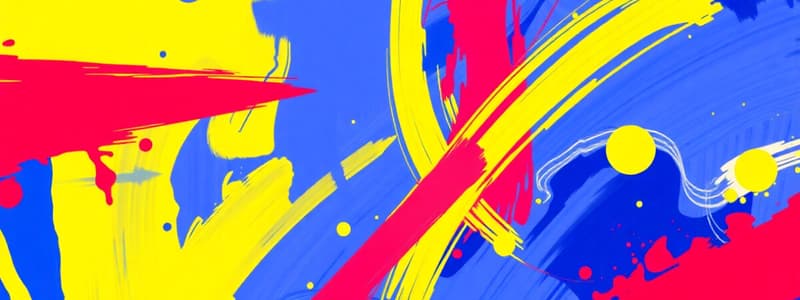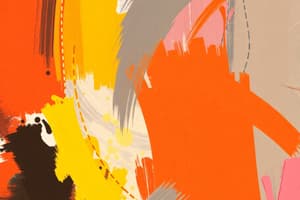Podcast
Questions and Answers
What two tools in Photoshop are commonly used for removing small blemishes in an image?
What two tools in Photoshop are commonly used for removing small blemishes in an image?
- Patch Tool and Clone Stamp Tool
- Spot Healing Brush and Healing Brush (correct)
- Healing Brush and Clone Stamp Tool
- Spot Healing Brush and Patch Tool
When using the Healing Brush, how do you tell Photoshop which pixels to use for replacement?
When using the Healing Brush, how do you tell Photoshop which pixels to use for replacement?
- Use the 'Content-Aware' option in the brush settings
- Click on a clean area while holding down the Option key (correct)
- Select a brush type that uses 'Proximity Match'
- Photoshop automatically identifies the best replacement pixels
The Spot Healing Brush tool blends the new and old pixels together to create a seamless patch.
The Spot Healing Brush tool blends the new and old pixels together to create a seamless patch.
True (A)
What is the main difference between the Healing Brush and the Spot Healing Brush in how they choose replacement pixels?
What is the main difference between the Healing Brush and the Spot Healing Brush in how they choose replacement pixels?
What is the function of the 'Sample All Layers' box in the Spot Healing Brush options?
What is the function of the 'Sample All Layers' box in the Spot Healing Brush options?
The three types of Spot Healing Brushes are Content-Aware, Create Texture, and ______.
The three types of Spot Healing Brushes are Content-Aware, Create Texture, and ______.
Which of these options is NOT a blend mode available in the Spot Healing Brush options?
Which of these options is NOT a blend mode available in the Spot Healing Brush options?
A softer brush setting in the Spot Healing Brush tool will create sharper, more noticeable edges for the repaired area.
A softer brush setting in the Spot Healing Brush tool will create sharper, more noticeable edges for the repaired area.
It is generally recommended to remove large objects in a single, continuous swipe with the Spot Healing Brush tool.
It is generally recommended to remove large objects in a single, continuous swipe with the Spot Healing Brush tool.
What is one of the advantages of using a separate layer for Spot Healing?
What is one of the advantages of using a separate layer for Spot Healing?
How can you adjust the size of the Spot Healing Brush tool?
How can you adjust the size of the Spot Healing Brush tool?
What is one of the ways to prevent a repeating pattern from being introduced when Spot Healing?
What is one of the ways to prevent a repeating pattern from being introduced when Spot Healing?
Which of the following tools might be better suited for repairing near a hard edge, where the Healing Brushes might cause a blur or warping?
Which of the following tools might be better suited for repairing near a hard edge, where the Healing Brushes might cause a blur or warping?
Using the Content-Aware type of Spot Healing Brush will always produce the best results for any type of object or blemish.
Using the Content-Aware type of Spot Healing Brush will always produce the best results for any type of object or blemish.
Briefly explain the concept of Spacing in the Spot Healing Brush tool.
Briefly explain the concept of Spacing in the Spot Healing Brush tool.
Why is it important to create a blank layer for Spot Healing?
Why is it important to create a blank layer for Spot Healing?
The Spot Healing Brush tool can only be used to remove single spots or blemishes. It is not suitable for removing lines or larger objects.
The Spot Healing Brush tool can only be used to remove single spots or blemishes. It is not suitable for removing lines or larger objects.
Name one advantage of removing smaller sections of a large object or line when using the Spot Healing Brush tool.
Name one advantage of removing smaller sections of a large object or line when using the Spot Healing Brush tool.
Flashcards
Spot Healing Brush Tool
Spot Healing Brush Tool
A Photoshop tool used to remove small blemishes, dust spots, or trash from images.
Healing Brush Tool
Healing Brush Tool
A Photoshop tool used for minor imperfections, similar to the Spot Healing Brush but requires manually selecting replacement pixels.
Clone Stamp Tool
Clone Stamp Tool
A Photoshop tool that copies and pastes pixels without blending.
Patch Tool
Patch Tool
Signup and view all the flashcards
Content-Aware Tool
Content-Aware Tool
Signup and view all the flashcards
Spot Healing Brush Types
Spot Healing Brush Types
Signup and view all the flashcards
Sample All Layers
Sample All Layers
Signup and view all the flashcards
Brush Size
Brush Size
Signup and view all the flashcards
Brush Hardness
Brush Hardness
Signup and view all the flashcards
Brush Spacing
Brush Spacing
Signup and view all the flashcards
Blend Mode
Blend Mode
Signup and view all the flashcards
Spot vs. Line Removal
Spot vs. Line Removal
Signup and view all the flashcards
Removal Strategies
Removal Strategies
Signup and view all the flashcards
Spot Healing on Layers
Spot Healing on Layers
Signup and view all the flashcards
Pixel Replacement
Pixel Replacement
Signup and view all the flashcards
Zoom Level
Zoom Level
Signup and view all the flashcards
Image Magnification
Image Magnification
Signup and view all the flashcards
Separate Layers for Spot Removal
Separate Layers for Spot Removal
Signup and view all the flashcards
Healing Brush Algorithm
Healing Brush Algorithm
Signup and view all the flashcards
Pixel Sampling
Pixel Sampling
Signup and view all the flashcards
Content-Aware Spot Healing
Content-Aware Spot Healing
Signup and view all the flashcards
Brush Type Selection
Brush Type Selection
Signup and view all the flashcards
Photoshop Tools
Photoshop Tools
Signup and view all the flashcards
Repeating Patterns
Repeating Patterns
Signup and view all the flashcards
Study Notes
Adobe Photoshop Spot Healing Brush Tool
- Photoshop's Spot Healing Brush tool effectively removes small blemishes and objects from images.
- It's simpler to use than the larger objects, like the Patch tool, for removals.
- Easily confused with the Healing Brush; Spot Healing Brush is faster and automates pixel replacement.
Spot Healing Brush vs. Healing Brush and Clone Stamp
- Spot Healing Brush uses an algorithm to select replacement pixels, while the Healing Brush requires manual selection of replacement areas (hold Option/Alt key).
- The Spot Healing Brush blends new and old pixels seamlessly, unlike the Clone Stamp tool. It is intended for small object removal.
- The Healing Brush gives a user more control over pixel replacement but may not be ideal in every unique scenario.
Spot Healing Brush Usage Steps
-
Create a blank layer: Create a new layer (Layer > New > Layer, or shift + ⌘N) for working on the Spot Healing process, separate from your original image. This way you'll retain the original image intact.
-
Zoom in: Use the Magnifying Glass tool or Command + to zoom into the area for precise adjustments and to remove spots/lines more accurately. Use Command 0 to return to normal image size.
-
Select Spot Healing Brush: Select the proper tool from the Photoshop toolbar. Choose the Spot Healing Brush, not the Healing Brush.
-
Adjust Spot Healing Brush size: Adjust the size of the Spot Healing Brush to be slightly larger than the area you want to remove. Utilize the Size sliders or the bracket keys ([ and ]) on the Options bar for size adjustments.
- Softer brushes feather edges for better blending, while harder brushes create sharper edges.
-
Select Brush Type: Choose among Content-Aware, Proximity Match, or Create Texture for Spot Healing brush:
- Content-Aware: Algorithm searches for suitable pixels.
- Proximity Match: Uses pixels around the spot for replacements.
- Create Texture: Generates a pattern for pixel replacement.
-
Sampling: Enable "Sample All Layers" to access pixels from all visible layers in the image.
-
Remove spots/lines: Click once on the spot/line you want to remove. Repeat clicks or other methods for effective removal, exploring different brush types or sizes if needed.
-
Spacing, Blend Mode, and Tool Adjustments: Adjust the spacing between brush strokes, blend mode interactions with existing pixels, or change directional movements for cleaner results, particularly on problematic elements.
-
Removing Lines: Use the Spot Healing Brush to remove lines by adjusting the spacing and blending settings and/or using several small clicks rather than one large drag.
Tips for Using the Spot Healing Brush
- Spot vs. Line: Click once to remove an object, not drag the brush. Use a larger brush for one-click removals. Choose smaller removals/ sections if you're working with complex outlines or line paths.
- Direction Change: Vary the direction of brush strokes for improved results. For example, move from left to right, top to bottom, or center outward.
- Brush Size Change: If the brush size is inadequate, change it to better than the object being removed to prevent leaving a problematic ring effect.
- Section Removal: When removing large objects or lines, remove smaller sections first. Start with sections that are easier to heal.
- Multiple Clicks: Repeat clicks might produce more precise results. Trying different brush types or sizes may be an alternative.
- Avoid Overuse: Repeated use in the same spot may introduce artifacts or noticeable patterns.
Studying That Suits You
Use AI to generate personalized quizzes and flashcards to suit your learning preferences.



